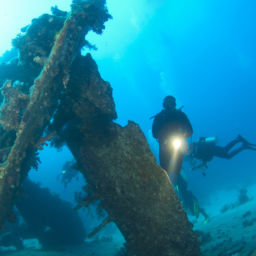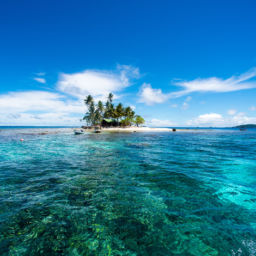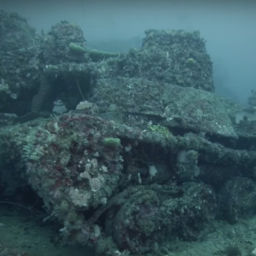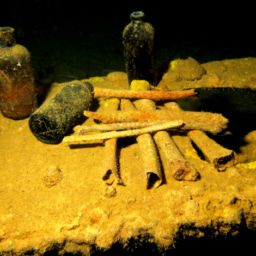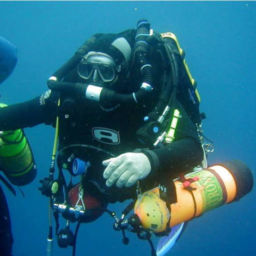Chuuk Lagoon is well known as a wreck diving Mecca, with over 40 Japanese shipwrecks, a submarine and numerous planes scattered on the bottom in the warm, tranquil lagoon waters. While we have written about diving Chuuk before, here we focus specifically on the logistics of tec diving Chuuk Lagoon.
What happened here?
Chuuk Lagoon was the home of the Japanese Imperial fleet during WWII. During Operation Hailstone, in February of 1944, the U.S. managed to decimate the ships in Chuuk, creating the scene that is now home to some of the most historically appealing wrecks in the world. There are over 40 dive-able wrecks — mostly ships, although there are four planes and a submarine as well — in the lagoon. These are mostly merchant freighters, many with cargoes intact inside the holds. Tankers, submarine tenders, tugs and destroyers also litter the seafloor. Divers can still find trucks, tanks, cars, plane parts, guns, ammunition, shells, torpedoes, telegraphs, crockery, gas masks and shoes on these wrecks. Those with the proper training can tour intact engine rooms as well.
Aside from the history on display, beautiful soft corals and sponges also cover many of the wrecks. They provide shelter for schools of jacks, barracudas, snappers and a good variety of reef fish. Divers will regularly see reef sharks, eagle rays, turtles and dolphins.
What are dive conditions like?
The conditions in Chuuk couldn’t be easier. The water is warm, from 82 to 85 F (28-29 C). There are no thermoclines and currents are minimal. And since most of the wrecks sit on white sand, there is plenty of light. Visibility varies by dive site, typically reaching 100 feet (30 m) at the 4th fleet anchorage (where the deep wrecks lie). It’s 70 feet (20 m) around Uman Island (the 6th fleet anchorage) and around 50 feet (15 m) at the repair anchorage. Viz stays the same throughout the year.
Tec Diving Chuuk Lagoon
I dove Chuuk Lagoon for the first time this year, leading a group of both recreational and technical divers. Many wrecks are suitable for both skill levels, and as such, we put together an itinerary that met the needs of both groups and delivered the very best wrecks.
On most of the wrecks, a deep-air decompression certification is sufficient, such as PADI Tec 50, IANTD Technical Diver or TDI Extended Range. However, for wrecks beyond 165 feet (50 m), we’d recommend trimix training, particularly if you’re penetrating the wrecks. Silt-outs are always a risk, and if parts of the wreck have deteriorated, your buoyancy and finning techniques must be impeccable. It’s rare to lay line out in these type of wrecks, so divers must be comfortable with progressive-penetration style navigation and exiting in a silt-out or low-visibility situation.
Technical divers who want to make extended dives typically dive once in the morning and again after lunch. Recreational divers generally prefer two-tank morning dives followed by an afternoon dive. Wrecks sit in depths ranging from 40 feet to 210 feet (12 m to 64 m), and 70 percent of them are within recreational depth limits. Following is a brief description of a few of the best spots for tec diving Chuuk Lagoon, all included on our itinerary.
Technical Dives of Chuuk Lagoon
Heian Maru
Average depth: 75 feet (23 m)
Maximum depth: 100 feet (33 m)
The Heian Maru, which lies on its port side and is the largest intact wreck in the lagoon. The Japanese military converted the ship from a passenger liner into a sub tender, and on the bow you can clearly read the name in both English and Kanshi, which is Japanese poetry written in Chinese by Japanese poets. The front cargo holds contain many long-lance torpedoes and shells; the back holds have radios and medical supplies. In the superstructure, you’ll find china, periscopes, telephones, beds, books and many bathrooms. The engine room is easily accessible, with lots of valves, gauges and indicator lights, making for excellent for photographs.
Fujikawa Maru
Average depth: 80 feet (25 m)
Maximum depth: 115 feet (35 m)
The Fujikawa Maru is Chuuk’s most famous wreck, sitting upright in the lagoon. Inside the holds you’ll find Zero fighter plane fuselages, other plane parts, machine guns and many shell casings. If you’re going to penetrate the wreck, the engine room is a must, especially the tool rooms and the lower sections. Outside, both the bow and stern have large gun emplacements. The steering flat has an emergency compass and helm, along with numerous hoses and tools.
Fujisan Maru
Average depth: 162 feet (49 m)
Maximum depth: 200 feet (61 m)
This tanker sits upright with a strong list to port and extensive bomb damage to stern. Anchors are out and front holds are caved in at the sides. The superstructure is accessible, and although the engine room is not easy to reach, it’s well worth a visit.
Nippo Maru
Average depth: 120 feet (37 m)
Maximum depth: 155 feet (47 m)
There’s lots to see on this wreck, which sits upright. On the deck is a small tank, three howitzer field guns, anti-aircraft gun and a truck frame. In the holds are shells, detonators, gun cases, sake and beer bottles, huge water tanks, gas masks, mess kits and rifle ammunition. A telegraph and binnacle sit on the photogenic bridge. You can access the engine room through a torpedo hole in the side or from the superstructure.
Aikoku Maru
Average depth: 165 feet (50 m)
Maximum depth: 210 feet (64 m)
A huge explosion completely destroyed the forward part of this troop carrier, which sits upright. Divers can still find anti-aircraft guns and a large stern gun pointing skyward from where they last fired in battle. Check out the memorial plaques and Buddha statue on the deck. Inside the superstructure, you’ll find many bathrooms; inside the holds, you can tour temporary troop quarters. Engine room penetrations are advanced, but well worth it for qualified divers.
Hoki Maru
Average depth: 115 feet (35 m)
Maximum depth: 165 feet (50 m)
The Hoki Maru, which sits upright, could aptly be called an underwater truck parking lot. Visit the aft hold to see trucks, tractors, a steamroller and a bulldozer balanced precariously on the cross beams. You can also find depth charges, spare propeller blades and aerial bombs on the wreck. The forward half of the ship was split and folded out by a huge explosion. Advanced penetration opportunities exist in the engine room and superstructure. The tip of the bow remains intact.
San Francisco Maru
Average depth: 165 feet (50 m)
Maximum depth: 210 feet (64 m)
Sitting upright in the lagoon, the San Francisco Maru is Chuuk’s most famous deep dive. There are three tanks on the deck, as well as trucks, aircraft engines and china in the second hold. Divers can find hemispherical mines in the first hold, along with torpedoes, bombs, hundreds of depth charges and cordite containers. There is also a well-preserved bow gun. The engine room offers easy access. The back holds are filled with ammunition, torpedoes and other cargo, and there are depth charges on the stern.
Kensho Maru
Average depth: 90 feet (27 m)
Maximum depth: 130 feet (40 m)
The easily accessible engine room is a must on this wreck, which sits upright. Divers can explore three levels, full of tools, gauges and machinery in great condition. In the superstructure visit the galley, bathtubs, toilets, radio room and bridge, where you can find the telegraph. On deck, there is a great bow gun and in the aft hold is a collection of bicycles, welding supplies and a large salvage pump. You can swim through the steering flat and exit through a bomb hole in the stern.
Katsuragisan Maru
Average depth: 190 feet (58 m)
Maximum depth: 230 feet (70 m)
Sitting upright, the Katsuragisan Maru is the most recent discovery in Chuuk Lagoon. The ship sank when it hit a mine in the northeast pass, and sits in an exposed location close to the pass. You’ll need calm weather to get to this rarely dived site. Decks are covered in lanterns, and in the holds you can find rolled-up fencing, ammunition, trucks and radio equipment.
Shotan Maru
Average depth: 140 feet (42 m)
Maximum depth: 180 feet (55 m)
You’ll find bottles, ammunitions, a large portable generator, and the damaged remains of trucks inside the forward holds of this ship, which sits upright. Aft of the superstructure, anti-aircraft guns have fallen through the deck, and sit one level down. The engine room is accessible from inside the superstructure, and is well preserved. The aft holds are heavily damaged, nearly splitting the ship in two. On the stern you can find a gun and emergency steering helm.
Oite
Average depth: 190 feet (57 m)
Maximum depth: 205 feet (62 m)
This destroyer is split into two pieces. The bow is upside down, while the stern section sits upright. Located in the northern part of the atoll, it’s an exposed location, so calm weather is essential. Anti-aircraft guns, a main battery gun and depth charges are on the deck. You can find torpedo launchers on the sand nearby, with torpedoes loaded inside. The engine room is accessible, but tight. Inside the bow section you can access crew sections and the galley. The two massive propeller, which gave the ship a maximum speed of 37 knots, are very impressive.
Sankisan Maru
Average depth: 80 feet (24 m)
Maximum depth: 90 feet (27 m)
The aft of the Sankisan Maru is completely missing, but the stern is upright and sits 330 feet (100 m) away from the rest of the ship. In the forward holds are thousands of bullets, a variety of truck chassis, machine guns, aircraft engines and cowlings, as well as hundreds of small medicine bottles. Some of the best soft corals in the lagoon adorn the decks and masts.
Nagano Maru
Average depth: 180 feet (55 m)
Maximum depth: 210 feet (64 m)
This cargo ship, which sits upright, features an intact truck in hold No. 2, along with a train-track assembly, two more trucks, and large construction equipment and trailers. There’s china in hold No. 3, and you can access the engine room from multiple paths.
Betty Bomber
Average depth: 60 feet (18 m)
This intact airplane sits upright and features a large entrance for a nice swim through the fuselage. Outside there are many artifacts, including a radio and machine gun. You can also take a fun photo on the toilet. A short swim away, you’ll find the two engines, plus some other damaged planes.
Emily Flying Boat
Average depth: 50 feet (15 m)
Maximum depth: 60 feet (18 m)
The largest plane wreck in the lagoon sits upside down, with a 124 foot (38 m) wing span. The “Emily” suffered a fair amount of damage, but the props are still on the plane and the shallow part of the hull is smothered in soft corals. Look for the pontoon floats and also the anchor eye, which is still in place.
Make it happen
There are a number of both land-based and liveaboard options for visiting divers.
Getting there: Our group flew from various countries and transited through Hawaii, Japan or Korea and then on to Guam. Most Chuuk-bound divers will have a one-night layover in Guam.
Visas: You can get a visa upon arrival in Chuuk when traveling from most countries, so no advance planning was necessary. However, do check on visa requirements for transit countries when stop-overs are required.



